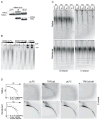5' C-rich telomeric overhangs are an outcome of rapid telomere truncation events
- PMID: 23347616
- PMCID: PMC3594334
- DOI: 10.1016/j.dnarep.2012.12.008
5' C-rich telomeric overhangs are an outcome of rapid telomere truncation events
Abstract
A subset of human tumors ensures indefinite telomere length maintenance by activating a telomerase-independent mechanism known as Alternative Lengthening of Telomeres (ALT). Most tumor cells of ALT origin share a constellation of unique characteristics, which include large stores of extra-chromosomal telomeric material, chronic telomere dysfunction and a peculiar enrichment in chromosome ends with 5' C-rich overhangs. Here we demonstrate that acute telomere de-protection and the subsequent DNA damage signal are not sufficient to facilitate formation of 5' C-overhangs at the chromosome end. Rather chromosome ends bearing 5' C-overhangs are a by-product of rapid cleavage events, processing of which occurs independently of the DNA damage response and is partly mediated through the XRCC3 endonuclease.
Copyright © 2013 Elsevier B.V. All rights reserved.
Conflict of interest statement
The authors declare that they have no conflict of interest.
Figures




References
-
- Greider CW, Blackburn EH. Identification of a specific telomere terminal transferase activity in Tetrahymena extracts. Cell. 1985;43:405–413. - PubMed
-
- Bryan TM, Englezou A, Dalla-Pozza L, Dunham MA, Reddel RR. Evidence for an alternative mechanism for maintaining telomere length in human tumors and tumor-derived cell lines. Nat Med. 1997;3:1271–1274. - PubMed
-
- Londono-Vallejo JA, Der-Sarkissian H, Cazes L, Bacchetti S, Reddel RR. Alternative lengthening of telomeres is characterized by high rates of telomeric exchange. Cancer research. 2004;64:2324–2327. - PubMed
-
- Bechter OE, Shay JW, Wright WE. The frequency of homologous recombination in human ALT cells. Cell Cycle. 2004;3:547–549. - PubMed
Publication types
MeSH terms
Substances
Grants and funding
LinkOut - more resources
Full Text Sources
Other Literature Sources
Research Materials
Miscellaneous

